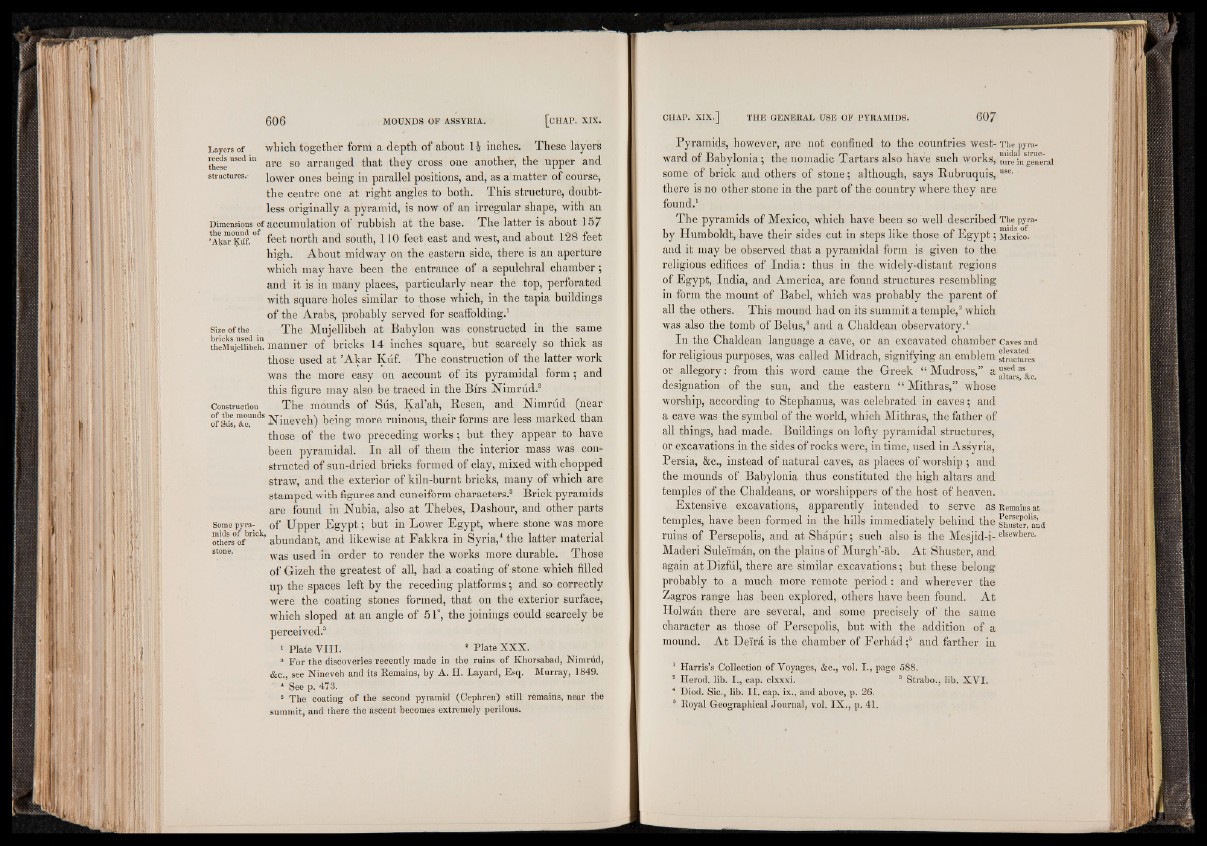
Layers of which together form a depth of about 1£ inches. These layers
th e s eUSedm are so arranged that they cross one another, the upper and
structures.- ]0Wer ones being in parallel positions, and, as a matter of course,
the centre one at right angles to both. This structure, doubtless
originally a pyramid, is now of an irregular shape, with an
Dimensions of accumulation of rubbish at the base. The latter is about 157
’AkS°KAf. °f feet north and south, 110 feet east and west, and about 128 feet
high. About midway on the eastern side, there is an aperture
which may have been the entrance of a sepulchral chamber;
and it is in many places, particularly near the top, perforated
with square holes similar to those which, in the tapia buildings
of the Arabs, probably served for scaffolding.1
size of the The Mujellibeh at Babylon was -constructed in the same
SeMujembeh! manner of bricks 14 inches square, but scarcely so thick as
those used at ’Akar Kuf. The construction of the latter work
was the more easy on account of its pyramidal form; and
this figure may also be traced in the Birs Nimrud.2
Construction The mounds of Sus, Kal ah, Besen, and bii in n id [near
of ^ , r ndS Nineveh) being more ruinous, their forms are less marked than
those of the two preceding works; but they appear to have
been pyramidal. In all of them the interior mass was constructed
of sun-dried bricks formed of clay, mixed with chopped
straw, and the exterior of kiln-burnt bricks, many of which are
stamped with figures and cuneiform characters.3 Brick pyramids
are found in Nubia, also at Thebes, Dashour, and other parts
Some pyra- of Upper Egypt; but in Lower Egypt, where stone was more
™hers°ofbrlCk’ abundant, and likewise at Fakkra in Syria,4 the latter material
stone- was used in order to render the works more durable. Those
of Gizeh the greatest of all, had a coating of stone which filled
up the spaces left by the receding platforms; and so correctly
were the coating stones formed, that on the exterior surface,
which sloped at an angle of 51°, the joinings could scarcely be
perceived.5
' Plate V I I I . 2 H a te XX X .
3 F o r the discoveries recently made in the ruins of Khorsabad, Nimrud,
&c., see Nineveh and its Eemains, by A. H. Layard, Esq. Murray, 1849.
4 See p. 473.
5 The coating o f the second pyramid (Cephren) still remains, near the
summit, and there the ascent becomes extremely perilous.
Pyramids, however, are not confined to the countries west- The pyra-
ward of Babylonia; the nomadic Tartars also have such works, mre^gsmerai
some of brick and others of stone; although, says Rubruquis, use-
there is no other stone in the part of the country where they are
found.1
The pyramids of Mexico, which have been so well described The pyra-
by Humboldt, have their sides cut in steps like those of Egypt; Mexico,
and it may be observed that a pyramidal form is given to the
religious edifices of India: thus in the widely-distant regions
of Egypt, India, and America, are found structures resembling
in form the mount of Babel, which was probably the parent of
all the others. This mound had on its summit a temple,2 which
was also the tomb of Belus,3 and a Chaldean observatory.4
In the Chaldean language a cave, or an excavated chamber caves and
for religious purposes, was called Midrach, signifying an emblem structures
or allegory: from this word came the Greek “ Mudross,” a S&jjj&H
designation of the sun, and the eastern “ Mithras,” whose
worship, according to Stephanus, was celebrated in caves; and
a cave was the symbol of the world, which Mithras, the father of
all things, had made. Buildings on lofty pyramidal structures,
or excavations in the sides of rocks were, in time, used in Assyria,
Persia, &c., instead of natural caves, as places of worship ; and
the mounds of Babylonia thus constituted the high altars and
temples of the Chaldeans, or worshippers of the host of heaven.
Extensive excavations, apparently intended to serve as Remains at
temples, have been formed in the hills immediately behind the swer'and
ruins of Persepolis, and at Shapur; such also is the Mesjid-i-elsewhere-
Maderi Suleiman, on the plains of Murgh’-ab. At Shuster, and
again at Dizful, there are similar excavations; but these belong
probably to a much more remote period: and wherever the
Zagros range has been explored, others have been found. At
Holwan there are several, and some precisely of the same
character as those of Persepolis, but with the addition of a
mound. At Dei'ra is the chamber of Ferhad ;5 and farther in
1 Harris’s Collection of Voyages, &c., vol. I ., page 588.
8 Herod, lib. I., cap. clxxxi. 3 Strabo., lib. X V I.
' Diod. Sic., lib. I I . cap. ix„ and above, p. 26.
5 Boyal Geographical Journal, vol. IX ., p. 41.